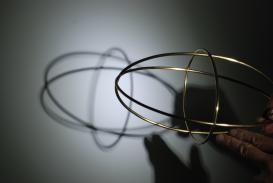In her dissertation Anja Sattelmacher examined the rapprochement between so-called “mathematical intuition” (Anschauung) and practical application of mathematics in 1830–1914, which was promoted by the Mathematics Professor Felix Klein and his colleagues throughout German universities, schools, and technical colleges. Subject of my investigation are mathematical model collections at German universities, which increasingly emerged since about 1870, and which were designated in particular for the training of mathematics teachers and engineers. The starting point for the production and use of mathematical models was the idea that mathematical teaching should be less formal and static and more “intuitive.”
Hence, Anja Sattelmacher addressed the question of how, in a time in which the visualization of mathematical facts was rather neglected by mathematicians, due to the development of non-Euclidean mathematics, a large number of mathematicians and teachers pushed forward these so-called intuitive mathematics (anschauliche Mathematik).
Her project intersected with the history of science and media and cultural studies, and she paid close attention to the materiality of the objects studied, as well as on the way they functioned as mediators within the specific disciplines that they helped to develop. Anja Sattelmacher was particularly interested in the question of how the material aspects of scientific objects—such as their weight, density, and mutability—influence their epistemic function within educational contexts.

